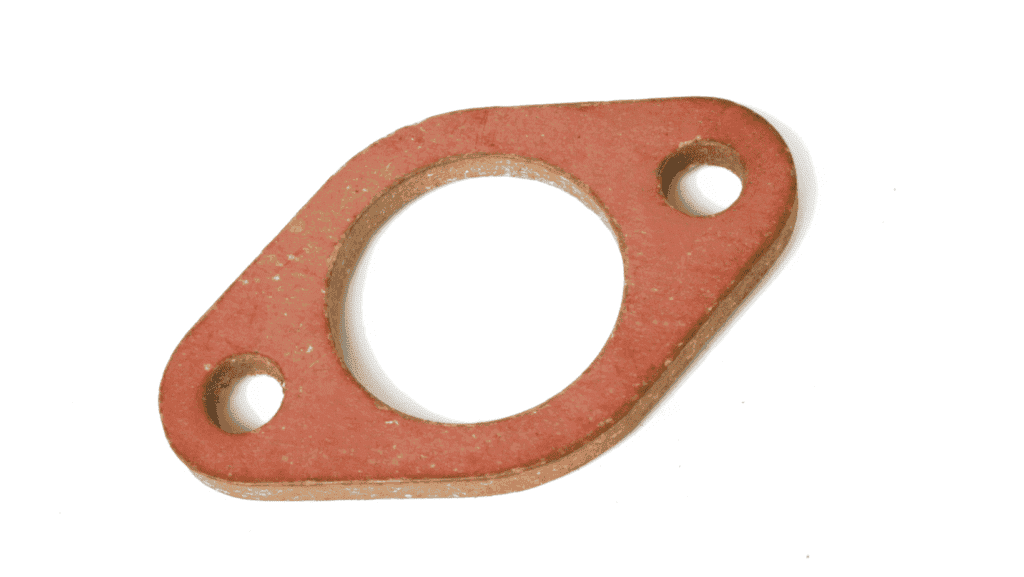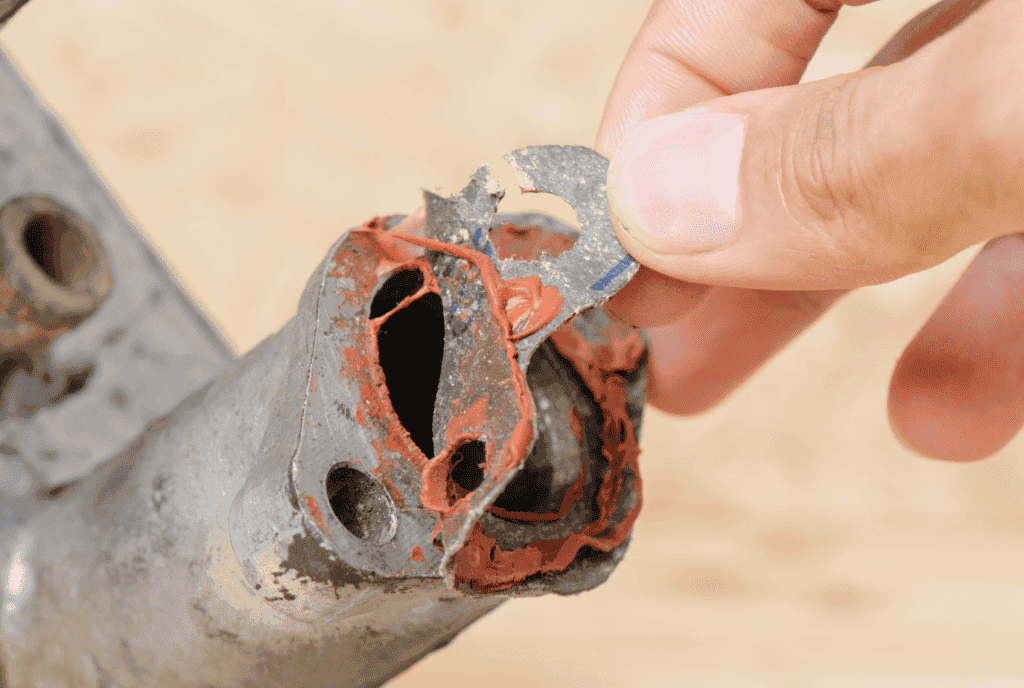
Whether you’re fixing your exhaust or simply replacing it, you’ll have noticed that there is a gasket, metal shim, or some type of metal sealing device in between the exhaust manifold and the engine. Gaskets are an important part in keeping a motorcycle functioning properly. After removing your exhaust, you may be wondering if it’s good practice reuse the same gasket or if you need to get a new one.
Can you reuse motorcycle exhaust gaskets? You can reuse motorcycle exhaust gaskets. If you do use the original exhaust gasket, perform a visual inspection to ensure there are no brittle areas or cracks on the sealing surface. Also ensure that you don’t have any exhaust leaks after you reassemble the exhaust.
Gaskets serve a critical purpose on all sorts of different components on your motorcycle. This could be to keep certain fluids or gasses inside of the system and/or to keep things out of the system. There are all sorts of different types of gaskets and seals on your motorcycle as well. Regardless of what type, their purpose is just to act as a seal.
Why It’s Okay To Reuse Motorcycle Exhaust Gaskets
Most of the time when you purchase a replacement component for something on your motorcycle, it will come with new seals. This could be new O-rings, new gaskets, or a “form-a-gasket” paste. All of these are there so that when you install your new part, you can also install it with all new seals. This way you don’t have to worry about worn or damaged seals leading to leaks or components failing.
Replacing gaskets and seals is generally a very straightforward process. Gaskets are generally made out of graphite, fiber, or metal and O-rings are often made out of different types of rubbers. If you ever plan on reusing a seal of any type, it’s best that you inspect it first and ensure that it doesn’t appear damaged. Otherwise, you may just need to pull everything apart again to change out that seal shortly afterwards.
Motorcycle exhaust gaskets have the responsibility of sealing in exhaust gasses. These connect between the exhaust manifold or the header and the cylinder head. If they are not working properly, exhaust gasses are able to leak through. Is this a big deal?
Leaking exhaust gasses can be a big deal. They can lead to bad motorcycle performance, loss of power, and a higher amount of emissions being generated. None of this stuff is incredibly dangerous on its own nor does it pose much risk of damaging your motorcycle. More than anything it is just annoying because now you have to pull everything back apart to replace the exhaust gasket.
So, why can you reuse motorcycle exhaust gaskets? Exhaust gaskets do eventually wear out, but they last quite a long time. If it passes inspection, it will probably still seal fine. Also in a motorcycle, getting access to the exhaust gasket is also a little bit easier than in a car. This makes tearing everything apart to replace it if needed, not quite such a big deal.
So while it generally is recommended to replace a used exhaust gasket, you will oftentimes be fine to just reuse it. You will just want to be sure to check it for any exhaust leaks after you have reinstalled it to ensure that it’s sealing. And if there are any leaks, fortunately this doesn’t mean there is much risk to you or your bike until you have time to install the new exhaust gasket.
How To Tell If An Exhaust Gasket Needs To Be Replaced

So, how you can you tell if your motorcycle exhaust gasket needs to be replaced? The first thing that you can do is a visual inspection of the gasket. Look for any cracks or excessive wear on the gasket. If you notice any of these, then it probably needs to be replaced.
Even if you don’t notice any visible damage to the gasket, that doesn’t necessarily mean that it’s going to seal still. If the gasket has become distorted in any way either from compression, heat, or something else, then it may not seal when put back together again. That is why once you have reinstalled an exhaust gasket, you should always check for any sort of exhaust leaks coming through the gasket. We will dive a little deeper into how you can check this.
How To Check For Leaks Around Reinstalled Exhaust Gaskets
The best way to check for exhaust leaks is to start with a visual inspection. Look at the exhaust system around the gasket after taking your motorcycle for a few miles ride. If you notice any sort of black deposits or dark marks around the gasket, then you very well might have a leak which is leaving this soot residue. Although, if you just reinstalled your exhaust gasket and haven’t run it much, you likely won’t see this until you’ve ridden your motorcycle for a bit.
You can also try using the paper towel method to test any sort of exhaust leak. While your motorcycle is running, you can wave a paper towel around the area where the gaskets are located. Remember that the exhaust will get very hot while running so you will want to ensure your hand doesn’t touch any part of the exhaust system or engine. If you notice the paper towel moving or pulsing with the rhythm of the exhaust around the location of the exhaust gaskets, then you have an exhaust leak.
Some leaks may be too small to be noticeable with the naked eye. If you still think that you might have an exhaust leak, you can pour water on your exhaust around the gasket while the engine is cold. Then start the bike up and keep an eye on that gasket. If you notice any bubbling of the water in that area, then that means you have a leak. Adding soap to that water can make this method even more effective. You can read our more in-depth article about how to check for motorcycle exhaust leaks by clicking here.
How Long Do Motorcycle Exhaust Gaskets Last?
You may be wondering about how long your exhaust gasket should be good for. Fortunately, these last quite a long time. The original OEM gaskets that come from the manufacturer on a new motorcycle are generally made out of high-quality materials that will last you years to come. These generally last anywhere from 20,000-50,000 miles which is about the expected life of most motorcycles. That means in a lot of cases, you may never even need to worry about replacing an exhaust gasket although some older bikes may start to develop issues.
Aside from OEM gaskets, there are also various aftermarket gaskets that you might have on your motorcycle. You could have these either because you had to replace the OEM gasket or because you installed an aftermarket exhaust manifold. High quality aftermarket exhaust gaskets are similar in quality to OEM ones. So, if you are buying them from a refutable company, you can expect it to last about as long as the original one. If you are buying a cheaper, lower quality one, it likely will not last as long though.
What Are The Different Types Of Motorcycle Exhaust Gaskets?
There are several different types of exhaust gaskets on motorcycles. This is often dependent on the bike you have, the time when your motorcycle was made, different engine configurations, and also any sort of aftermarket components that you might have added. Knowing what type of exhaust gasket that you have is important if you are planning on replacing it and want to be sure that you get the right kind.
The most common types of exhaust gaskets on motorcycles are:
- Copper Crush Gaskets
- Fiber Gaskets
- Graphite Gaskets
- Multi-Layer Steel Gaskets
- Solid Copper Gaskets
- O-ring Gaskets
- Compressed Fiber Gaskets
If you do want to replace the gasket on your motorcycle, then you will want to be sure of what type you have. Additionally, certain types of gaskets are more reusable than others. For example, a copper crush gasket probably won’t be able to be reused. That is because when it is compressed, it deforms in order to provide a seal. Once deformed, it might not be able to seal properly once re-compressed.
